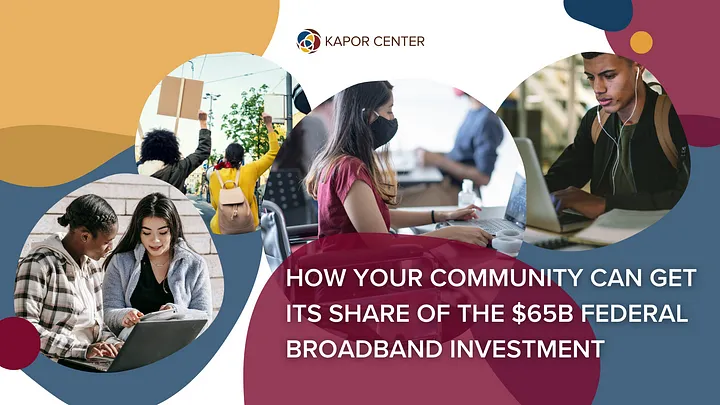The past two years have laid bare a shameful historic lack of meaningful investment in the digital infrastructure that has left generations without an adequate strategy and implementation plan to modernize schools, healthcare, the workforce, and more — leaving cities, suburbs, and rural areas all unprepared to rely on digital alternatives when the pandemic hit; and revealing long-standing inequities in access to broadband and devices. It has been made clear: access to technology and the know-how to use it is critical to participation in our digitally-driven world. Digital access is a civil rights issue.
An estimated 19 million Americans lack access to reliable broadband, and low-income households, tribal and rural communities, and Black and Latinx households are much more likely to be disconnected from the broadband critically needed to learn, work, and thrive.
With COVID-19’s unilateral shift to distance learning, 15–16 million K-12 public school students lived in households without access to education because they lacked either an internet connection or a device sufficient for remote learning, severely impacting low-income students, students of color, and rural students. Beyond the lack of access to broadband networks, Black, Latinx, Tribal, and rural communities are less likely to have broadband that is reliable and has adequate speed, and are more likely to face affordability challenges.
Fortunately — although not until two years into the pandemic — the federal government is taking action through the Infrastructure Investment and Jobs Act of 2021, investing a historic level of $65 billion across the country to fund broadband network deployment, adoption, and other broadband-related programs. However, accessing this funding isn’t easy — local advocates need to know what it funds, who can apply, and when the actual funding will arrive. We must ensure the communities that need these funds most understand how to access and leverage them in their neighborhood, city, and/or state.
To help state or local organizers bring these funds to their communities, Kapor Center has created this downloadable guide — outlining which programs specific communities can apply for to start building this long-needed digital infrastructure.
While these historic investments are definitely a step in the right direction, there’s much more work to be done. We need more funding across the board paired with adequate planning and implementation to create real change. And, while the federal government can do more, so can the states — and some states are.
Enter: California. California has taken the initiative to make historic state-level investments to bridge the digital divide. In 2021, Governor Gavin Newsom announced a $6 billion plan — including 18 middle-mile broadband infrastructure projects — with the goal of increasing internet access for unserved and underserved communities across the state. Along with the federal funding, this will make a big difference for communities like Oakland, which despite its close proximity to Silicon Valley, exemplifies the negative dichotomy between high income and high poverty. In Oakland, four state highways will be included as part of the statewide “middle mile” fiber optic infrastructure investment.
So, what’s the problem? Due to the FCC connectivity maps’ overestimations, systemically underinvested low-income and urban areas run the risk of being mislabeled — as “connected.” And, if middle and last mile investments are not fully funded to account for these mislabeled urban, low-income areas — which have unknown levels of unserved or underserved broadband access — cities like Oakland run the risk of increased digital redlining. It is critical that middle mile and last mile infrastructure is funded appropriately, with granular data transparency that shows data speeds by income and zip code.
Currently in Oakland, there is no data to show whether a building that is considered “connected” is actually connecting every unit, or even if every unit has working fiber or coaxial wiring. In other words, even when we think we’re counting everyone, Oakland is evidence that unserved communities are not accurately captured. What we do know is that Oakland’s current connectivity maps reflect the 1930s redlining maps — showing the disproportional underinvestment in infrastructure in communities of higher Black and Latinx population. Middle and last mile infrastructure programs need to closely consider these realities; however, there is currently an opportunity to correct these wrongs and comment on the rulemaking governing and how we count connectivity at the federal and state level.
To help state or local organizers mobilize their communities — in places like Oakland and across the country — and ensure critical information and resources reach the communities disproportionately impacted by a lack of broadband access, Kapor Center has created this downloadable guide.
Oakland is not alone. Investments are being made across the country — oftentimes at both the federal and state levels — but cities such as Oakland, Detroit, and Los Angeles need equitable, not equal investment given their urban low-income dense areas. Until equitable investments are made, and until we stop overestimating connectivity in urban, low-income areas, racial and economic disparities will continue to flourish. We must hold the federal government accountable to ensure equitable investments — that take into account racial, economic, geographic, performance, and cost factors — into their evaluation and funding allocation processes, so that national infrastructure is truly working to close the digital divide. This accountability should also be mirrored to ensure last mile, local jurisdictions are held accountable to equitably investing in their own people.
For more information on additional federal broadband programs on the horizon across, we encourage you to review Common Sense’s guide.
Federal Broadband Funding Opportunities
Your advocacy is just the start. We must do more. Inequitable access to reliable broadband harms the daily lives of millions of residents across the United States. And, this urgency will only increase as technology continues to advance. Historic investments are the first step, but it’s past time to take one hundred more. Without equitable connectivity, the cascading effects of educational and economic gaps will continue, and the impact will be felt across our nation for generations to come.

